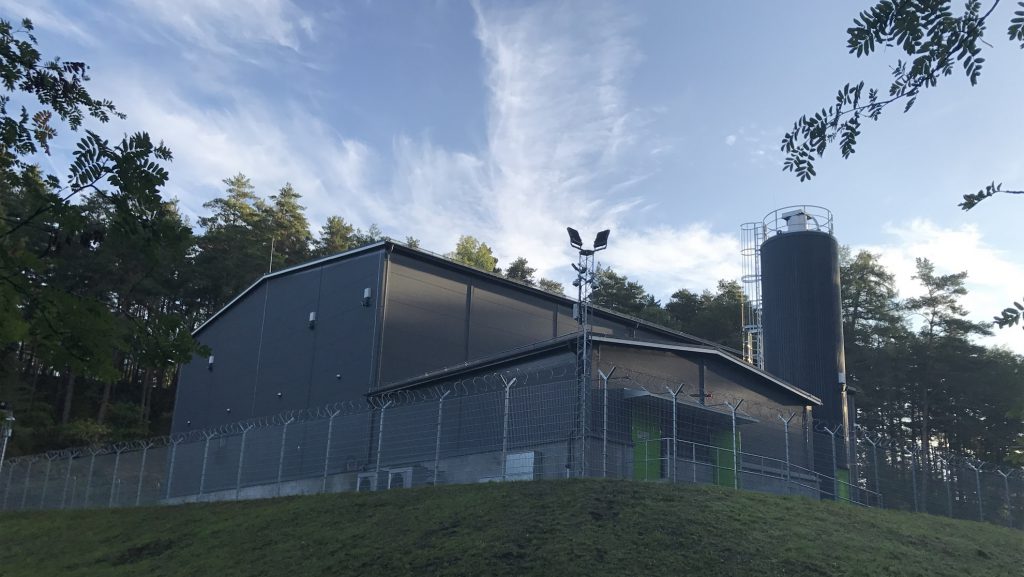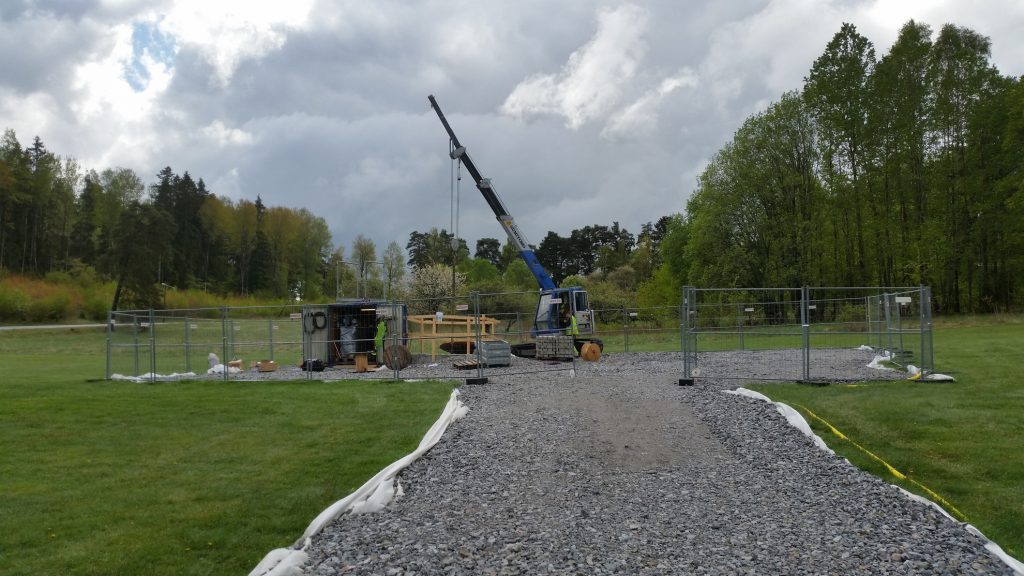Bornsjoverket reservoir cleanup scores ‘Excellent’
Overview
This project involved cleaning up a reservoir near Stockholm to ensure it could be used as a safe supply of drinking water. The team used advanced techniques to remove phosphorous, while taking great care to minimise disturbance to this nature-rich area. They were rewarded with nearby sea eagles raising a chick - and with a BREEAM Infrastructure rating of Excellent.
Background
Bornsjön is a water conservation area and Stockholm Water and waste reservoir. It is also of great significance for the entire Stockholm County as it is the only reserve water revenue of a reasonable size that can provide the county for a long period in the event that all or part of Lake Mälaren would become unfit for drinking water production. In order to ensure water quality in the lake and the supply of drinking water so that the lake can be used as water reservoir in the future, the problem of internal phosphorus loading needed to be addressed.
Challenges
The main objective of the project was to secure Bornsjön as a reserve water area for the future by addressing the internal phosphorus load in the lake. The water treatment plant continues every August to October to reduce the phosphorus in the lake without traditional cleaning processes. To use such a technique for cleaning a lake is unique in the world and will be watched by many in the coming years.
Impacts of the cleanup
The direct effect is that Bornsjön's ecological status is improved and that the lake will continue to be used as a reserve water supply and safe delivery of drinking water. Further effects are that Bornsjöverket will increase the maximum capacity and flexibility of Norsborgs waterworks. The temperature of outgoing drinking water at Norsborgs waterworks is sometimes close to and sometimes just above the National Food Agency’s limit value of 20 degrees. A supplement of 1000 m3 / h from Bornsjön can reduce the temperature by barely a degree during the summer months. Alkalinity from Norsborgs waterworks is today below the recommended limit of 60 mg / l. The high alkalinity of Bornsjön would increase this, thus reducing corrosion on the pipeline. Another effect of the plant is that the recovered sludge from the cleaning process in Bornsjöverket will be used on fields in the area as fertilizer.On the 7th of September 2017 Bornsjöverket was opened by politicians and the CEO of Stockholm water and waste. The project was end inspected and all the water tests were completed with very good results.

Solutions
The project is very unique and is situated in an environment that placed extremely high demands on the project team. Clear procedures and plans were put in place to prevent any negative environmental impacts from the project.
Management and planning
Early on, the team created an extensive risk list, project plan, waste and mass management plan and joint organisational plan with the client. The contract was a design & build contract that was carried out in collaboration with both the client and subcontractors. This was important to make everyone move in the same direction. The team worked with well with cohesion, a success factor for the BREEAM Infrastructure work.
The team replaced the machine suppliers twice during the project because they did not live up to environmental requirements. High demands also require careful follow-up. Weekly environmental and protection rounds and extensive personal introductions were a cornerstone of the work.
The project received some attention in the media and a number of articles were published. the client has also twice been interviewed about the project on the radio. Monthly progress reports clearly demonstrated the project progress in both image and text, and these were highly appreciated and spread both internally within Skanska and at the customer. This was an effective way to engage the final user (who operates the plant).
Early on, the team set goals and structure for how to establish and operate the workplace. The project achieved internal eco labelling “Green Workplace” with the highest level “Gold”. In addition, a “green map” explained progress during the project in the areas of energy, materials, climate and water.
Transport
Thanks to the “unloading pocket” the team managed to arrange early in the project, there was minimal disturbance to traffic in the area. Steered drilling was used to avoid road breaking. Traffic arrangement plans have been carried out, monitored and successfully end inspected by authorities.
The subcontractor managed to change a long-haul transport by lorry to be partly transported by boat and only the last bit of lorry, which meant a lower environmental impact.
People and communities
Close collaboration with the customer’s warden and network contributed to good cooperation with the various associations and residents in the area. Since it is a rich nature and open-air area with many active people, it was very important that the workplace and the finished plant melted well into nature and that it was not restricted to people’s ability to move around in the area. Several consultations and information meetings were held during the project. This was highly appreciated by the public.
Environmental disturbance was minimised during the production phase. A major challenge was the foundation of knocked piles at different levels. The production manager together with geotechnicians and designers worked out a method of joining piles in the air. This resulted in a shorter time for piling and avoided significant noise and vibration.
Land use and landscape
Very little temporary land use was used in the project. The areas used were carefully covered with geotextile and protective materials and then restored to their origin on project completion. The project had the possibility of storing masses as the client had several workplaces in the area with different time frames and material requirements. This enabled us to reuse all the masses that did not contain too much clay. No soil contamination was encountered or arisen during the project. The project applied and received grants early to try a portable method for testing contamination of masses and water. This method was instructive, and can provide major benefits for managing masses.
In the design of the project, great importance has also been given to handling stormwater and possible contamination from vehicles in the future. A gravel tank/storage and a “disaster well” to minimise the spread of any leakage have been built into the parking area in front of Bornsjöverket.
The water environment
Water issues have naturally been of the utmost importance for this project. Extreme focus was placed on not affecting the aquatic environment during the construction period and in the future when Bornsjöverket is in operation. Precise water measurements were made during the construction period, both to check turbidity and water quality in terms of drinking water production. Materials incorporated into the plant and especially those components that may come into contact with drinking water have undergone careful evaluation. Our principle was that you can eat it, you can build it.
In the shafts, grumbling ponds caught cloudy particles before the water was led to the lake and turbidity curtains efficiently collected particles and materials. In order to minimise the risk of spillage and leakage from tanks and parked vehicles, areas were carefully secured with double protection (plastic sheets, gravel and geotextile) to easily collect polluted material if an accident would occur. Upon introduction, everyone received a thorough review of how a possible environmental accident should be handled, and this was successfully tested during the project.
Ecology and biodiversity
The environmental impact assessment was a sacred script throughout the works. All routines, plans and preparations were developed based on the project EIA. A number of unusual bird and fish species lives in the area, which were taken care of during the course of the project. The work was moved in time to avoid disturbing birds, techniques such as steered drilling have been used to minimise turbidity to not disturb playing pike and work boats used in the lake were sprayed before launching to remove any diseases.
The client had good contact with birdwatchers in the area and who also had an appreciated presentation of the birds around Bornsjön for the entire project. During the course of the project, sea eagles incubated an eagle chick - which showed good management consideration during the turbulent and environmentally sensitive project process.

Benefits
The big challenge was to comply with the high demands of the many natural values and stakeholders in the area. It was a great challenge to work with drinking water and to research and submit proposals on products/materials that have to meet the high demands made by the client.
BREEAM Infrastructure brought economic benefits as well as a sense of pride to work towards a clear goal and then achieve it. It also improved relationships with residents and associations, as local communities and stakeholders were more involved than in previous projects.
This project pioneered best practices in several areas:
- The layout area for vehicles and leakage preparations.
- Involvement of stakeholders in the area.
- Design of building and workplace to minimise environmental impact.
- Interest and commitment to technical solutions that saved us time and resources as well as a high commitment to environmental issues throughout the project.
Summary
Linda Strand (Skanska Sverige AB)
